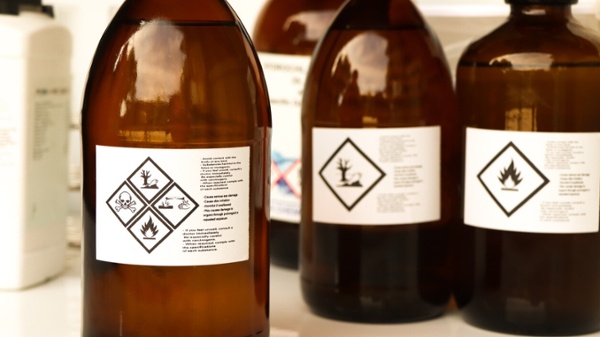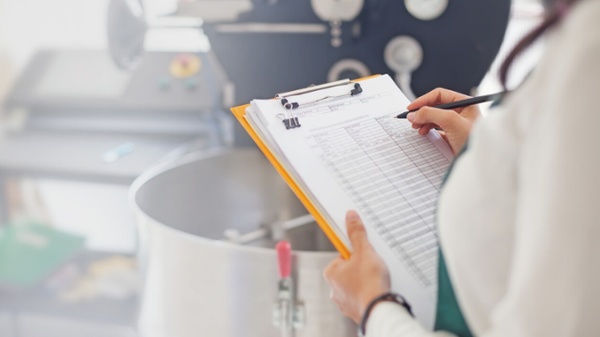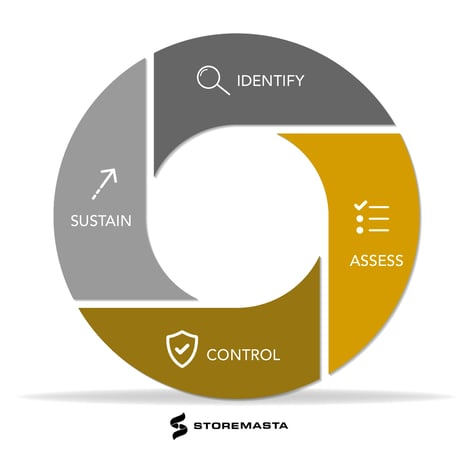Most workplaces across the world carry some sort of hazardous chemical. However, it’s important to remember that hazardous chemicals present several risks upon the people in your workplace. To help mitigate these risks, the hazards associated with dangerous substances must be controlled in a systematic manner. In this post, we’ll be looking at a 4-step methodology for managing risk so you can move from identifying and assessing your situation to controlling and sustaining your chemical controls.
How Do You Manage Chemical Risk?
When you’re dealing with multiple chemical substances across many dangerous goods classes, controlling every chemical risk in your organisation may seem like an overwhelming task. However, the key to controlling chemical hazards is by breaking down the process into 4 distinct phases.
Here at Storemasta, our Dangerous Goods Storage Consultants recommend applying our 4-step risk control methodology to improve health and safety at your site. We’ll explain this more in detail in the next section.
The Storemasta Risk Management Methodology
Controlling the risk associated with hazardous chemicals is one part of the four phases of the methodology that we utilise to manage the risks of hazardous chemicals in the workplace.
The Storemasta methodology has four phases: Identify - Assess - Control - Sustain.
The way that this methodology can be used to manage hazardous chemicals in the workplace is that you must first identify and assess their potential risks. This must be done before any controls are implemented to mitigate the risks associated with hazardous chemicals.
Identify
Identifying risk is a process that involves identifying situations involving hazardous chemicals that could potentially harm people. This is generally carried out with a comprehensive onsite inspection of all areas which may present a chemical hazard
Assess
Once the potential risks associated with hazardous chemicals have been accurately identified, the risk must be assessed.
A risk assessment will allow you to calculate the magnitude of the risk by determining the severity and likelihood of an incident occurring. By assessing risk in your work areas, you will be able to evaluate what would happen if someone was exposed to your hazardous chemicals.
Control
Once you have identified and assessed the severity of the risks, you will have valuable data that will allow you to determine the best methods that should be used to control the risk. Controls can be a wide range of solutions from engineering controls, such as a chemical storage cabinet or bunded storage, to administrative controls, such as tighter controls on chemical inventories. We’ll go into further detail about this in a moment.
Controls, such as compliant storage, should be determined and implemented after you’ve identified and assessed the risk in your workplace.
Sustain
Once the controls have been determined and implemented in your work areas, it’s time to move to the next stage of the process, which is to sustain the controls. This means that you must review the controls’ effectiveness — and set up a proactive system to sustain their effectiveness.
This proactive system generally consists of periodically scheduled risks assessments, as well as regular inspection and maintenance routines.
How to Control the Risk of Hazardous Chemicals
While we’ve detailed our 4-step methodology for managing chemical risk, it’s important to focus on controlling the risk associated with your onsite chemicals.
When considering your chemical controls, you must follow the hierarchy of controls.
Hierarchy of Controls
The hierarchy of controls is a system that outlines the chronological order in which you should implement controls to reduce chemical hazards.
This system ranks the effectiveness of the different methods of controlling risk — from those that provide the highest level of protection and reliability, to those that provide the least amount of reliability and protection.
Elimination
The risk control measure that has the greatest level of effectiveness is elimination. Before any other control measures are considered, elimination must be applied first. Elimination is the method of totally removing a hazard or hazardous practice from the workplace.
Some examples of the elimination of hazardous chemicals include:
- Eliminating the use of chemical adhesive by using fasteners such as screws or nails.
- Eliminating the use of flammable forklift gas by using electric power forklifts instead of LPG powered forklifts.
Substitution
If you can’t successfully eliminate the use of a hazardous chemical in your business, you must then try to substitute it.
Substitution is when you replace the use of a hazardous chemical with another chemical that is less hazardous and presents a lower level of risk.
Sometimes, substitution can be hard to achieve because the dangerous properties of hazardous chemicals are often what makes them very effective in manufacturing and chemical processes.

If it’s possible to substitute a hazardous chemical with a less harmful one, you should implement this change to help control chemical risk.
For example, when spray painting cars, it is very important that the thinner used to thin the paint evaporates very easily. However, the more easily a paint thinner evaporates the more volatile it will be. The more volatile a substance is, the lower its flash point and the more easily it will ignite in the presence of an ignition source.
Isolation
If it’s not possible to substitute the use of a hazardous chemical with another chemical that is less hazardous, you must then isolate the hazardous chemical from people and other incompatible substances.
This can be done in several ways, for example:
If one part of a manufacturing process involves the use of a hazardous chemical, you could build a ventilated enclosure over this part of the manufacturing process. This enclosure would stop the airborne contaminants from this area moving into other areas of the manufacturing facility where people are present. The airborne contaminants that are generated inside this enclosure should be vented to the outside atmosphere in a safe location where people don’t congregate.
When large quantities of hazardous chemicals are stored in the workplace, you could isolate these hazardous chemicals from people by storing them outdoors in a compliant chemical storage container. Isolating hazardous chemicals from people by storing them outdoors reduces the risk of harm to people in the event of a workplace fire or chemical spill.
Hazardous substances must also be isolated from other incompatible substances. If incompatible substances mix, it can result in violent chemical reactions that can harm people and property. Incompatible hazardous substances can be isolated by storing them in separate chemical storage cabinets and dangerous goods storage containers.
Engineering Controls
If isolation cannot be achieved, you can implement a range of engineering controls to reduce the risk associated with hazardous chemicals.
Engineering controls are physical in nature. They are devices or processes that eliminate exposure to hazardous chemicals.
Engineering controls can be used to:
- Minimise the generation of hazardous chemicals
- Suppress or contain chemicals
- Limit the area of contamination in the event of spills
Engineering controls can include devices such as mechanical ventilation systems, compliant chemical storage containers or the automation of processes involving the use of hazardous chemicals.
Administrative Controls
If there is still a chemical risk once higher order controls are implemented, then you must work to reduce this by developing administrative controls.
Administrative controls aren’t as effective as other controls, because they don’t control the hazard at its source. Administrative controls rely on human behaviour and supervision, therefore, they aren’t as consistent or reliable as other controls.

Administrative controls are reliant on the behaviour and supervision of your staff.
Administrative controls are generally written policies and procedures that outline the best work practices to minimise exposure to hazardous chemicals.
These policies can include things such as:
- Limiting the number of people exposed to hazardous chemicals in the workplace
- Reducing the duration and frequency of exposure to hazardous chemicals
- Reducing the quantity of hazardous chemicals kept on site through inventory reduction methods such as just-in-time (JIT) supply
Personal Protective Equipment
Personal protective equipment (PPE) should not be relied on to control risk alone.
Instead, you must work through every stage of the Hierarchy of Controls, while utilising personal protective equipment, as per the recommendations in safety data sheets and the relevant Australian Standard.
While other controls, such as chemical safety cabinets or inventory controls can reduce the risks associated with your chemicals, personal protective equipment is supplementary equipment to be used in conjunction with these controls – not instead of these controls. Personal protective equipment should only be used as a last resort when other more effective control measures have been used and the risk has not been eliminated.
Some examples of personal protective equipment can include:
- Chemical resistant glasses
- Face shields
- Chemical resistant gloves
- Protective clothing
- Shoe covers
- Respiratory equipment
Maintaining Chemical Hazard Controls – Your Obligations
It’s part of your WHS responsibilities to ensure that all controls are inspected and maintained to ensure that they are still effective and suitable for your operations.
Without the continued sustainability of controls, your workplace may be at risk of hazards if there are changes to chemical inventories, new staff members, alterations in work procedures, new environmental conditions or other implications that could impact the safety of your site.
Get your free cabinet checklist here
There are a few key considerations when looking at implementing an inspection and maintenance program for your hazard controls. These include:
Conducting Chemical Safety Audits
If you are serious about chemical safety, scheduling regular safety audits is a workplace essential. A chemical safety audit is a type of site inspection that examines work and storage areas to ensure that chemicals are being used, stored and handled correctly.
The most effective safety audits utilise a prepared checklist (based on the hazards identified during previous risk assessments) to ensure you don’t miss anything — and as well as check the effectiveness of implemented control measures. Your safety audit and checklist might include prompts for checking:
- HAZCHEM Registers and Safety Data Sheets
- Chemical expiry dates, as well as test dates of equipment and storage vessels
- Mandatory placards and signage
- Training records, permit expiry dates, or mandatory qualifications
- The state of PPE and if it’s being used correctly
- Compliance of chemical safety cabinets and storage areas
- Housekeeping and workplace hygiene practices
- Safety equipment and emergency plans
Even your audit checklist needs regular review and should be updated as legislation changes or new chemicals are introduced to the workplace.
Safety audits can be undertaken by a manager, an independent consultant, or an appointed safety team/committee. It’s always practical to consult workers from each area who are using, handling or storing the chemicals.
Maintaining and Updating Your Chemical Stores
One of the most common issues we find during onsite dangerous goods storage audits, is that older chemical cabinets or stores are in a state of disrepair – or are so outdated that they no longer comply with the current Australian Standard.
Your safety audits should pay special attention to chemical stores to ensure that staff are following housekeeping procedures and putting chemicals into the correct cabinets. Supervisors shouldn’t be waiting for a safety audit to enforce strict housekeeping practices. Leaking and broken containers can quickly start fires or contaminate soil and waterways.
In safety audits, we often see issues including:
- Flammable liquids cabinets recommissioned for other incompatible chemicals
- Obsolete flammable liquids cabinets that do not have self-closing doors.
- Gas cylinders standing unrestrained inside the gas bottle cage.
- Gas bottle cages located near the perimeter fencing and vulnerable to falling tree branches and other combustible debris.
- Chemical cabinets located near ignition sources eg, machinery that generates heat and work processes that generate sparks.
- Drums of waste oil left on the ground without any spillage precautions.
- Chemical containers with missing labels (or so worn they cannot be understood).
- Mixed classes of chemicals in the one cabinet. Eg, containers of corrosive degreaser at the back of a flammable liquids store.
- Cabinets with no Safety Data Sheets (SDSs) located close by.
- Using an old chemical cabinet for combustible liquids with a missing floor and spill sump.
- Containers with missing lids or put away with large amounts of chemical residue spilled down the outside of the container.
- Drums, tins, and portable chemical containers shoved into cabinet in a way that reduces the amount of containers that can be placed inside. Staff on subsequent shifts then leave chemical containers outside the cabinet or place them on top because they don’t know what else to do.
Even though a chemical safety audit will identify any or all these faults, it’s far better to implement good housekeeping procedures and have supervisors taking corrective actions with staff on a daily basis.
Maintaining control chemical control measures is about keeping your chemical stores clean, compliant and in good working order.
Controlling Chemical Hazards in Your Business
Due to the risks chemical hazards pose to the people in your business, you must minimise the negative effects of these hazards. It’s crucial that you implement the most effective controls first – with elimination being the highest order control within the hierarchy of controls.
If elimination cannot be achieved, the next most effective controls must be used which include substitution, isolation and engineering controls. The lower order controls, such as administrative controls and PPE, should not be used as a primary method to control risk but to supplement higher order controls.
To learn more about managing the risks associated with hazardous chemicals, download our FREE eBook by clicking on the image below.
Joining the team as a Dangerous Goods Storage Consultant, Melissa Hampton became Storemasta's Marketing Manager in late 2021. With extensive knowledge and experience in chemical compliance, Melissa is responsible for leading the Marketing team and helping shape their marketing strategy. In her spare time, you can find Melissa hiking, swimming and enjoying the great outdoors in beautiful north-west Tasmania.

-1.jpg?width=600&height=400&name=New%20Container%20(6%20of%208)-1.jpg)

